Figure 1- Genes involved in cannabis pathogen response across 42 Cannabis Cultivars
Many following this newsletter have seen the horrific consequences when Pharma can capture regulators and coerce the nation into mandated liability free medicine. One of my attractions to the Cannabis market is that is offers a new model of decentralized medicine that escapes much of this corporate capture.
But does it?
Will the Cannabis industry ultimately get pulled into the crony capitalism gravity well? It is possible but hopefully with some transparency we can avoid it.
This post will touch on a fraud that is occurring the cannabis space. This is evident via some recent FOIA work. I touched on some of this in this CEN cast but for the data jockeys, the hard data is embedded in the post below.
Disclaimer- I have been in this field for 13 years. I am conflicted as we make genomic tests for this industry. For those new to me, we started doing this in 2011. The 1st unbiased cannabis microbiome was observed with the first cannabis genome ever whole genome sequenced in 2011. We put this sequence data public as it was the right thing to do and ever since, our team has put more cannabis microbiomes public than anyone else on Earth (See Kannapedia.net). It is fair to say, we are subject matter experts and pioneers in this space. Our views on this topic are forged in 13 years of pounding away at this problem and the first conclusions we drew were invariable wrong and have been corrected through years of evidence showing us what is real. Constant customer and regulator feedback has sharpened the knife.
Today, we are going to focus on evidence over folklore. Data over DudeScience.
The Big Cannabis story begins with a CannMed presentation from Yasha Kahn. Yasha demonstrated that labs were cooking the books on THC values. The higher the THC potency the higher price you could capture for the product.
States demand ‘independent labs’ perform potency testing, so the grows hire labs to test their products and over time they fire the labs that give them honest results and move to the labs that inflate the THC levels. This is known as Lab Shopping in the industry. Yasha went on a FOIA crusade to get all this testing data public.
Not surprisingly the markets suspicions were supported by the date he collected. Yasha, working at a Cannabis testing laboratory, knew that no one would believe his data as his conflict could make people question if he was just throwing shade at his competitors. So we independently FOIA’d the data from the Massachusetts CCC (Cannabis Control Commission) and replicated Yasha’s findings. We don’t have all states data as some states are still hiding theirs (shame).
Regulators in some states are quick to act on this data but in other states like Mass, there is little to no action at all. One must keep in mind, that the regulators, while well intentioned, also rely on the cannabis tax base which is predominantly fueled by Cannabis growers tax receipts not the testing labs. The market for all cannabis lab testing is believed to be under $400M/year while the cannabis market on a whole is closer to $25B or 60X larger.
Keep in mind the state earns taxes on cannabis that hits the market, not cannabis that fails.
So the Lab-Grow relationship is conflicted and the Regulator-Grow relationship is conflicted. Most people in the field don’t see the Cannabis grow tax base as a conflict with their regulators as they likely are not informed on this Austrian economic position on the subtle ingredients for regulatory capture.
So the Grows have larger cashflows and can lobby for the regulations they want more readily than the consumers and labs. This leads to grows writing the regs they want to govern them.
An example of this “Grow Gone Wild” actually occurred in Oregon, where Aspergillus testing went into place to make the Oregons microbial testing up to date with neighboring states like California.
Oregon is notorious for growing 2-3 fold more cannabis than their state can consume and its also notorious for having the least stringent testing guidelines of any state in the country. This untested cannabis then diverts itself to tested California markets and competes with California cannabis while having a lower testing and grow cost structure. This is not legal but its been happening long before cannabis legalization efforts came to California. Oregon is a hot bed for growing some of the best Cannabis in the world.
So when the Aspergillus testing went into place some of the Oregon growers screamed armageddon and that these new ‘very high’ microbial failure rates were an economic burden bankrupting grows. They lawyered up, sued the regulators and rewrote the regulations to their liking.
What actually occurred?
Well, we now have the METRC testing data FOIA’d from the state to know it was all a facade from a few grows who overly relied on a few labs.
The data acquired via FOIA shows the Aspergillus testing induced a 4.3-8% fail rate on the industry for a microbe published to have a 50% mortality rate (Aspergillosis is a bitch). There is a litany of literature highlighting the risk of this pathogen.
While you will be hard pressed to find anyone in the cannabis field that has died from THC, pesticides, or heavy metals, you can find clinical papers highlighting deaths from cannabis microbial infections. This is not to undermine those other tests. Pesticide can enrich in extraction used for vape pens. I’ve highlighted just a few of these papers as we tried to warn the Oregon regulators that elimination of this testing was a bad idea.
If you are not willing to test for the number one risk in cannabis everything else is just theatre. But for the Cannabis grows, this 4.3% failure rate was too much to bear and they hired lawyers and drown the regulators in Lawfare to eliminate the testing. The regulators folded and put up a minimal fight despite all the data we handed them on the harms of Aspergillus and the success the testing has seen in other states.
Part of the trick to getting the regulators to fold was to exaggerate the fail rate and the economic impact of the regulation. Grows were citing 23% fail rates. The OLCC was citing 4-8% failure rates. Of course this distortion was paraded in under the banner of being a ban on Organic farming.
So we got our hands on the Oregon testing data to see what really occurred across all testing timelines and we compared this to Michigan and Nevada which has been Aspergillus testing for years.
Figure 2. Cannabis samples tested for Aspergillus in the state of Oregon vs Michigan. The failure rate is charted over time across all labs. You can see in the beginning and end of testing in Oregon there were inflated fail rates. As the volume picked up the fail rate got closer to Nevada and when it ceased it picked back up again.
Here is another view of the Michigan Aspergillus testing data across all labs that had at least 100 tests.
Figure 2B. Michigan Aspergillus testing by lab. Blue is a pass and Orange is a fail.
Here is Nevada Aspergillus flavus testing
Figure 2C. Nevada Aspergillus flavus testing by lab. Blue is pass. Orange is fail.
A closer inspection reveals one lab in OR which was not speciating the Aspergillus testing had much higher fail rates.
Normal failure rates in line with other States-
Figure 2D. Aspergillus testing in Oregon itemized by species.
Abnormal failure rates not in line with other States.
Figure 2E. Aspergillus testing in Oregon that did not speciate has a much higher failure rate. Seen in 2 of the labs in Oregon.
You can see these two labs compared to each other in terms of fail rate and their respective testing volume in Figure 2F.
Figure 2F. The testing volume compared to the failure rate from the 2 labs that did not speciate.
Note: We only included labs that contributed more than 100 tests to the data. When you include more, you indeed see some labs that have 100% fail rates.
Figure 2G. All Oregon labs testing for Aspergillus_spp and their fail rates. Some of the labs with lower test numbers in fact have higher fail rates.
Were these high failure rate labs ‘lab shopped’ out of the game? I think this underscores the importance of having public state to state comparisons available to know what is the expected fail rate seen historically. This is particularly important when labs/states are booting up a new test. PT testing is also important but we need better standards that have multiple different levels of Aspergillus spiked into them.
So if we take the labs that had more than 100 tests under their belt, the 23% failure was not in line with other states and was likely a results of certain labs running abnormal tests and perhaps some grows still burning this process in. Perhaps a few unlucky grows were getting this fail rate at a given lab but the market as a whole was not at 23% failure rate and was more in line with what the regulators forecasted at 4.3%.
There was also an enrichment for microbial failures in pre-rolls which are notorious for being the dregs of a cannabis grow ground up and repackaged. This was an important biological signal suggesting the Aspergillus testing data wasn’t pure noise as this lined up with other states.
There were three other arguments these grows used to sway the decision.
1)Aspergillus has never killed anyone in Oregon
2)Aspergillus testing will just induce more pesticide use
3)Aspergillus is ubiquitous.
Lets unpack these three arguments
Argument #1) It’s never killed anyone!
The first argument relies on the fact that Aspergillus infections are not reported to the CDC. The CDC has to go trolling through ICD10 codes in insurance databases to find these. This was in fact done by the CDC and published but this data was ignored.
Here is the 2016 CDC study of insurance codes (ICD10) that points to 3.5X more fungal infections for Cannabis users vs non-users and Aspergillosis and mucormycosis are the leading entries. The Grows eliminated testing for the 4 Aspergillus species that are most responsible for these health insurance costs.
The set of literature I provided the regulators in Oregon also includes other case studies documenting cannabis induced Aspergillosis fatalities that didnt occur in Oregon but frankly the list is smaller than it should be as prohibition kept people from sharing cannabis use with the medical community. It was not uncommon a decade ago for medical staff to call CPS (Child Protective Services) and have cannabis using parents lose custody of their children.
Patients kept quite about their drug use. So prohibition has kept many of the harms of cannabis in the dark and the grows are using this prohibition era of science to their advantage to claim no harm is on the record when they know damn well how prohibition drives all of this type of information under ground and the CDC study was a clear signal that we have a problem.
This struck home in Massachusetts when a Cannabis grow employee died on the job from an Asthma attack in the trimming room. The CDC paid this grow a visit and measured for microbials and endotoxin.
Argument #2) Aspergillus testing will incite others to use pesticides.
This audience likely knows how I feel about people using such logical lethargy. ‘Inciting others’ is a predictive argument that is hallow when challenged with data.
I have in fact made this argument in the past about non-specific Total Yeast and Mold (TYM) testing. Some states demand this far more cumbersome testing as it flags any yeast and mold. Well, not any but much more than a simple targeted Aspergillus test.
We also make qPCR tests for TYM testing but we have been actively educating regulators what a horribly unscientific concept this test is. It is far better to test for specific pathogens as your product fail rate will be below 4% and you are only failing for real human pathogens.
Total Yeast and Mold tests attempt to measure all yeast and molds present regardless of their human pathogenicity and the Cannabis batch failure rate is often north of 10%. Sadly these tests were initially established on petri dishes and only 5% of the yeast and molds in nature can actually grow on them. There is also a Total Aerobic Count (TAC) test that attempts to measure all bacteria but also fails miserably as often yeasts will grow on these plates or bacteria will grow on the TYM plates and the tests are very sensitive to the temperature you incubate at. Not very specific tests.
We can do much better than this on qPCR (targeting ITS for TYM and 16S for TAC) but the grows don’t want these tests to get more inclusive as they already fail 10% of the cannabis with the current 10,000 CFU/g action limits in many states.
So the TYM and TAC tarot card tests are misnamed. These are not a Total tests. They are Minority Yeast, Molds, and Bacteria tests as the majority of yeast, molds and bacteria don’t culture on these petri dishes.
Figure 2H. All Aspergillus fails in Nevada and Michigan compared to TYM failures.
Figure 2I. TYM failure rates across states. Not MD (Orange) Changed from 10K CFU/g to 100K CFU/g and dropped their fail rates for TYM below all other states. Nevada’s Aspergillus flavus is charted along side and has a lower fail rate than all 10K TYM CFU/g states.
For those familiar with the COVID controversies, these ‘Total” tests never identify a pathogenic microbe. They just count unidentified colonies. As a result they fail Koch’s Postulates and no one in the clinical world takes these tests seriously. It’s just a gravy train for the food industry and a relic of regulatory capture that was superimposed onto cannabis grows.
Try to find a clinical report of a patient dying for 10,000 CFU/g on anything. You won’t find it because the clinical literature demands one isolate the pathogen, perform Koch’s postulates and publish the pathogenic species name.
I am sympathetic to the grows on this case. This test has limited clinical value, causes 5-10X more failure than Aspergillus testing and will have a hard time surviving clinical scrutiny.
There may be an argument to use these tests before and after remediation as a proxy for how much endotoxin or mycotoxins might be present. Tess Eidem, PhD is worth following on this topic. There are tests that can directly measure endotoxins but they are not required for cannabis testing. 4 mycotoxins are required in some states but this doesn’t include the mycotoxins synthesized by Fusarium or Penicillium often found in Cannabis.
The use of such ‘Total’ tests also serendipitously bans the use of the greenest tech out there: Beneficial microbes. The best way to get rid of a pathogenic Aspergillus is to flood the plant with benign microbes that fill the niche. But as long as TAC and TYM testing is in place, grows will be forced to use pesticides or breed low microbial burden cannabis strains. Low microbial burden strains do exist and can reduce your microbial burden by orders of magnitude (Punja et al).
For more about Total Yeast and Mold Lab shopping - See my Twitter thread on this. The fail rates for TYM testing are so high that they induce lab shopping as much as THC. There are cultivars that are genetic-ly prone to cary more TYM and grows should take these more seriously to avoid getting mixed up in this lab shopping scandal that is unfolding.
Figure 3. Total Yeast and Mold failures across time in Massachusetts. LabZ Appears to have a 10,000 CFU/g ceiling. This is not natural data. LabB below has a normal distribution of CFU/g in Massachusetts. See the twitter thread for more details.
So could pesticide use be induced by 14% failure rate TYM testing? Perhaps but Oregon was replacing that with Aspergillus testing which fails 5-10X less material than TYM testing. In most states, 66 or more pesticides are tested for.
A Canadian study sheds some light on this. They looked at this problem with one of the most comprehensive pesticide screens published in cannabis to date: 327 pesticides.
This is important as most states only mandate testing 66~110 pesticides so this study gives us a sense of how many grows are playing cat and mouse with the pesticide regulations. The cat and mouse game goes like this: If they ban 66 pesticides, use the ones they don’t ban or don’t screen for in the labs.
This study demonstrated that the black market has 92% of the samples failing for pesticides while the legal market material only had a 6% positivity rate.
The black market had some samples with pesticides 3 orders of magnitude over the legal limit. The use of a broad 327 pesticide panel also answered how many pesticides showed up that were off the testing list. Malaoxon was found in the illicit market and Diclobenil in the legal market.
Figure 4. Gagnon et al. demonstrate the tested market has a 6% positivity for pesticide and a 92% positivity for the untested markets.
No evidence of increased Pesticide use nor ‘off list’ pesticide use in the legal market. In fact the opposite is true. It appears the Illegal market got worse while the legal market improved which implies the black market is the dumping ground for cannabis that can’t pass testing.
Canada has more stringent microbial testing than Oregon or California. It demands 10X lower TYM levels for dried cannabis and adds in additional Staph and Pseudomonas testing for inhaled extracts or oral use. They have not implemented Aspergillus testing but we already know from the testing data across multiple states that Aspergillus testing fails 5-10X less frequently than TYM at 10,000 CFU/g.
TYM testing at 1,000 CFU/g will have a much higher fail rate than 10% seen in TYM testing at 10,000 CFU/g. We have collected the patchwork of different state by state regulations here and will need to add Canada to the map.
Figure 5. Microbial testing regs in Canada.
A more recent study came out of the LA Times from Paige St. John.
This study didn’t have a black market control group and just surveyed tested products on the shelf in California. It found 25/42 samples surveyed failed pesticide screens when they expanded the pesticide screen to include pesticides outside of the 66 pesticides they must test for in California. This is not a peer reviewed study and its behind a paywall but its nonetheless helpful to comb through to see what types of pesticides they are detecting. The table in the study has more than 42 samples (155) to comb through so I suspect it was expanded after the first sampling.
Not surprisingly, this study was latched onto by some of the Oregon growers as proof that Aspergillus testing in California is raising the pesticide use. Of course, these arguments were unconvincing as the study had no control group looking at the untested market. The study is also focused on vape pens which can enrich pesticides in the extraction process and some black market vape pens are often made from synthetics which will be pesticide free but may contain non natural cannabinoids.
Additionally, the majority of the pesticides found were insecticides used to fight mites. A few samples had fungicides and one sample even had Fumitoxin which is a mycotoxin synthesized by Aspergillus fumigatus. This is a bit ironic as the California Aspergillus testing demands you test for Aspergillus fumigatus. So these growers are pointing to a study that shows fumitoxin contamination (something synthesized by Aspergillus fumigatus) while blaming the testing for that very organism as the reason for increased pesticide use!
Figure 6A. Anresco labs post about the pesticide they found in on the shelf California cannabis
The few fungicides detected were myclobutanil which is a nasty pesticide to have in vape pens as it turns into hydrogen cyanide when heated. This was the largest reason for pesticide failure in cannabis testing in California before Aspergillus testing was in place, yet its in the minority of samples tested in this study (11/117). The most frequent pesticide found was an insecticide (Chlorofenpyr).
See Josh Wurzers CannMed presentation from April 2016. This was before California had Aspergillus testing in place. You will note that Pesticide testing was not required in California at the time and his Limit of Detection was 10-100X over Oregons at the time.
This led to very high myclobutanil failure rates (39.9%) prior to Aspergillus testing.
Figure 6B. SCLabs pesticide screens before Pesticide testing was mandated in California. Very high failure rates are seen when TYM testing was in place but Aspergillus testing was not in place.
While some Oregon growers like to live in this world that cannabis products are harmless and need minimal testing, the CDC and government officials are taking a more stringent approach.
The EVALI crisis was linked to vape pens and while this is often blamed on Vitamin E acetate, not all pens found in the EVALI crisis had Vitamin E-Acetate which is a filler that has been in use for over a decade. We don’t really know what caused EVALI. It may have been combination of respiratory viruses and vaping with a yet to be identified adulterant or pesticide (nicotine pens were not free of it).
Figure 7. From the LATimes article on Pesticides found with on the shelf Cannabis in California.
One thing that is clear with transparent data is that the truth always comes out.
Below is the Pesticide failure data for the state of Oregon during the time frame before and after they implemented Aspergillus testing. Flat across all labs and a very low failure rate.
Figure 8. Oregon cannabis testing data showing pesticide failures over time across labs
Here is the Aspergillus testing and fail rate over that same time frame. The majority of the tests are being performed by Lab 15202.
Figure 9. Aspergillus failure rate in Oregon cannabis testing data. This data include labs with low testing volume and high fail rates.
These Aspergillus failure rates were knowable at the time by simply contacting other state regulators that had Aspergillus testing already in place for years.
So once again, the Growers narrative (perhaps derived out of using labs with low volume and high fail rates) didn’t match the regulators understanding of state wide failure rates. But now that that the data is public, we can see it was likely a data sampling distortion and a case of pitchforks and lawfare. A more nuanced look at the data would have shown that many labs had abnormal data compared to the historical testing pass rates in other states.
This pitchforking got so intense that a ‘Journalist’ fabricated a story that our company had conspired with a law firm to manufacture these regulations. The law firm implicated in pushed back on this slander and joined us in sending the magazine a letter demanding they provide proof of such a thing happening or face a defamation case from both us and their law firm. The magazine conceded they had no proof and retracted the article. The ‘Journalist’ issued a public apology for his fabricated article.
Figure 10. MoldGate fraud. False articles were circulated to influence the case to remove Aspergillus testing from the Oregon regulations.
To be fair to this journalist, our company did supply comments regarding Aspergillus testing during the public comment period but this had no connection to this law firm nor entailed any legal action by our firm. The OLCC accepted comments from many organizations during public comment periods, ultimately citing that they had consulted with California regulators to make their final decisions and our public comments arrived after this decision. California moved from using TYM testing to Aspergillus testing and noted it decreased failure rates.
The 3rd Argument) Aspergillus is everywhere.
This was another slight of hand where the growers claimed ‘Aspergillus’ the genus was ubiquitous in nature while ignoring the fact that the labs were only testing for 4 species out of 180. The old genus-species trick. They also referenced air sampling studies that sampled a cubic meter of air which is 1 millions times larger than the 1ml or 1 gram sample being testing in cannabis labs. The testing data above nullifies these arguments. If its so ubiquitous why do multiple states have low failure rates for these tests?
Its important not to collectivize. Many grows and labs are above board. Some are appalled at this lab shopping as it erodes trust in the legal markets. In California, the labs that brought forward the testing mess were met with death threats. I experienced less extreme threats as well when I was defending Aspergillus testing in Oregon.
Figure 11. Growers in Oregon threatening people advocating for testing.
The California regulators have since shut down a lab and fined a grower. 2 labs are suing many other labs for manipulating results. The state put $9 million into a state lab 4 years ago and its still not operational to spot check samples.
I think a more productive approach is to put all the data public for scrutiny and step up the secret shopper programs. Public data would have enabled the grows to see which labs were in spec with other states and this entire saga could have been avoided.
There are grows that on-board their own testing so they can optimize their process to be clean. This isn’t easy as you have to replicate this infrastructure in every state. Cannabis samples can’t be shipped across state lines. This forces labs and grows to replicate infrastructure in every state they operate in.
In Massachusetts, the 2 labs that highlighted testing data anomalies were inspected/raided by the regulators. This regulatory organization (CCC) is now under scrutiny by the Office of the Inspector general (OIG- Shapiro) and has yet to act despite the 3 years of data that demonstrate lab shopping in the state of Massachusetts.
Silver Lining-
The de-scheduling of cannabis will likely enable these grows to write off their business expenses on their taxes. Current 280E regulations prevent this and strain cannabis businesses financially. This may enable grows to onboard testing technology to help monitor these issues in more real time. We have several grows that have on boarded our MIC/MYRA Testing platform to manage Hop Latent viroid infections. These same systems can test for Sal/STEC and Aspergillus.
In conclusion, many of these regulators are immersed in a diversity, equity and inclusion trend occurring in our society. The equity they are not taking into consideration is economic equity and how deep pocketed grows can buy/influence the regulations they want while the smaller under funded labs and consumers are left as pawns on this economic chess board. They either face lab shopping economics and bend the numbers, or they pray the regulators will police the market with the tax base they have been granted. The black market is thriving at over 50% of the cannabis market.
If we don’t perform safety testing with transparent public data, why perform all this tax heavy kabuki theatre?
To assist in this goal, we have built a web tool that imports Cannabis testing from any State that can provide it. So far it is populated with NV, MA, MD, RI, OR, MI, WA. We plan to upgrade this server for public use shortly. Stay Tuned.
Acknowledgements-
We want to thank the regulators that have taken action and hope other regulators in more nascent states will reach out to you on how to police these new markets fairly and equitably. We believe putting this data public is the best public service you can offer as it invites many data analysts to help police this for you. Much of this data had to be extracted with FOIA requests which many states are still denying.
We want to thank James Macrae, Yasha Kahn, Jeff Rawson and Jamie Toth for data sleuthing and turning attention to the testing data. We want to thank many labs (MCR, ATOZ, Green, Modern Canna, Cambium, Analytics) that offered review of this work to help improve transparency and lab shopping.
MCR has put a public link to all of this data.
https://drive.google.com/drive/mobile/folders/1IIlgudS3b1rvxbupeMaR_BdeUQmz3pOZ?usp=drive_link



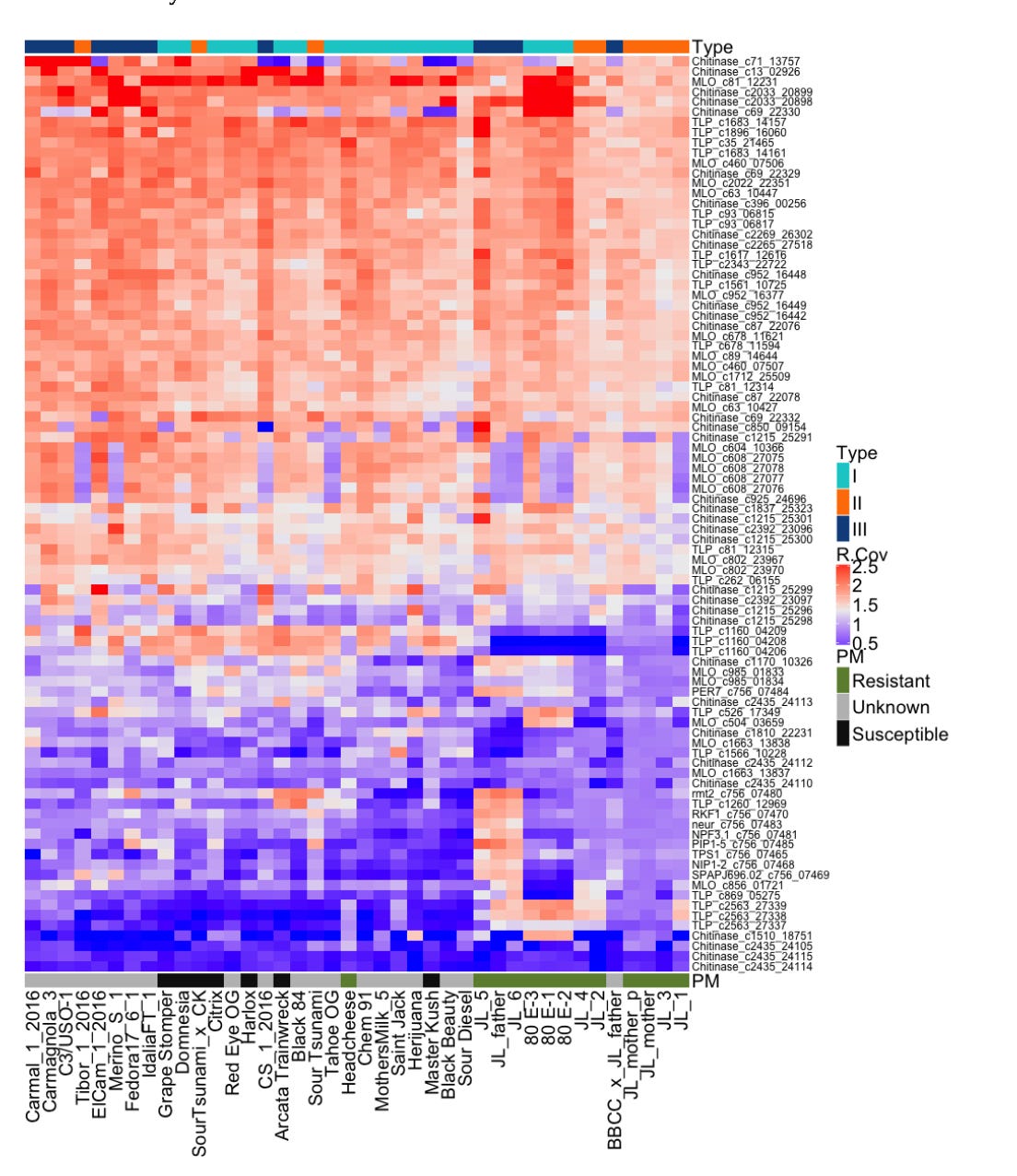

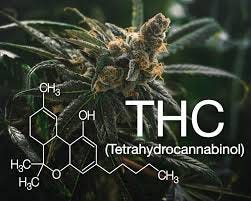



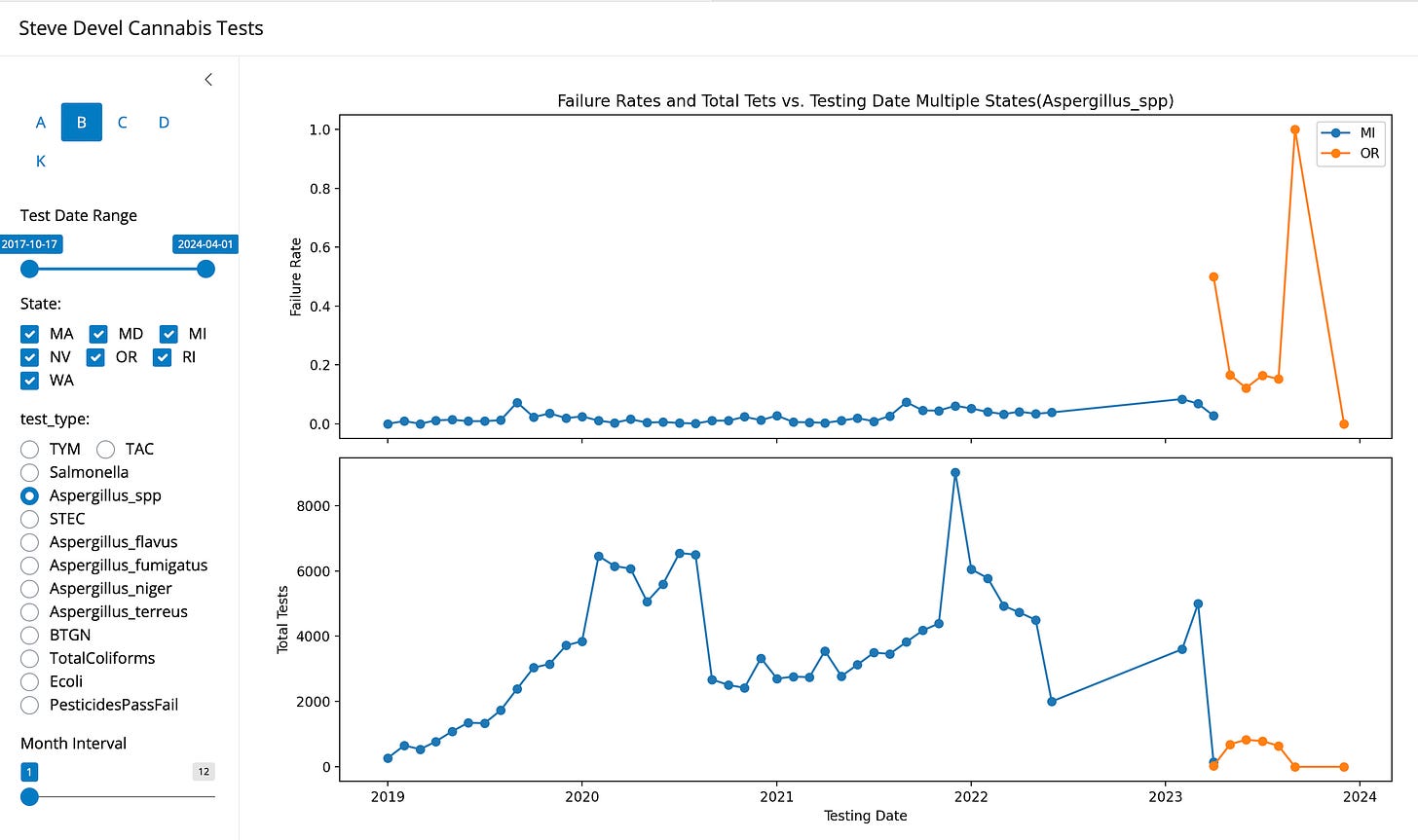
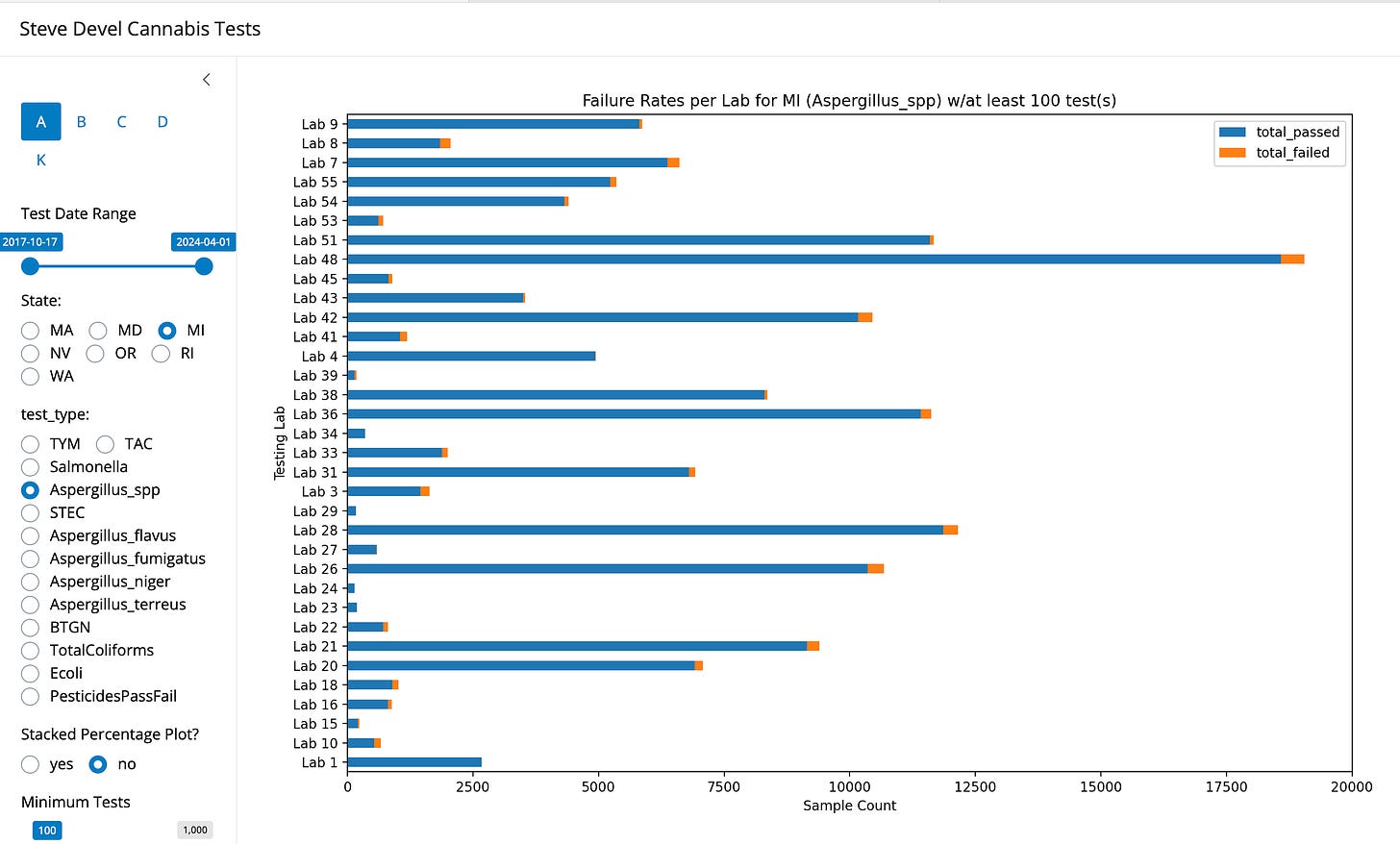
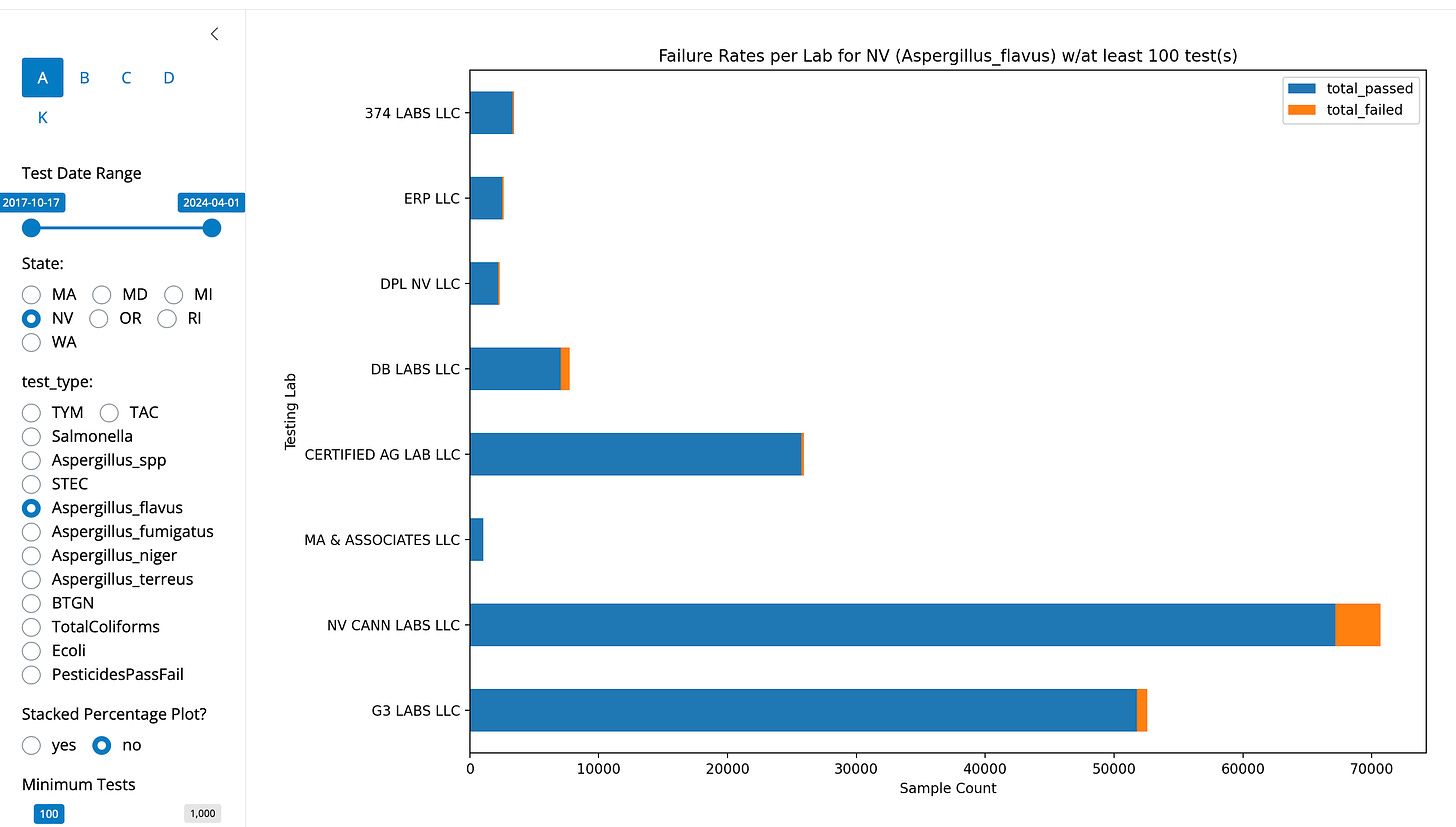
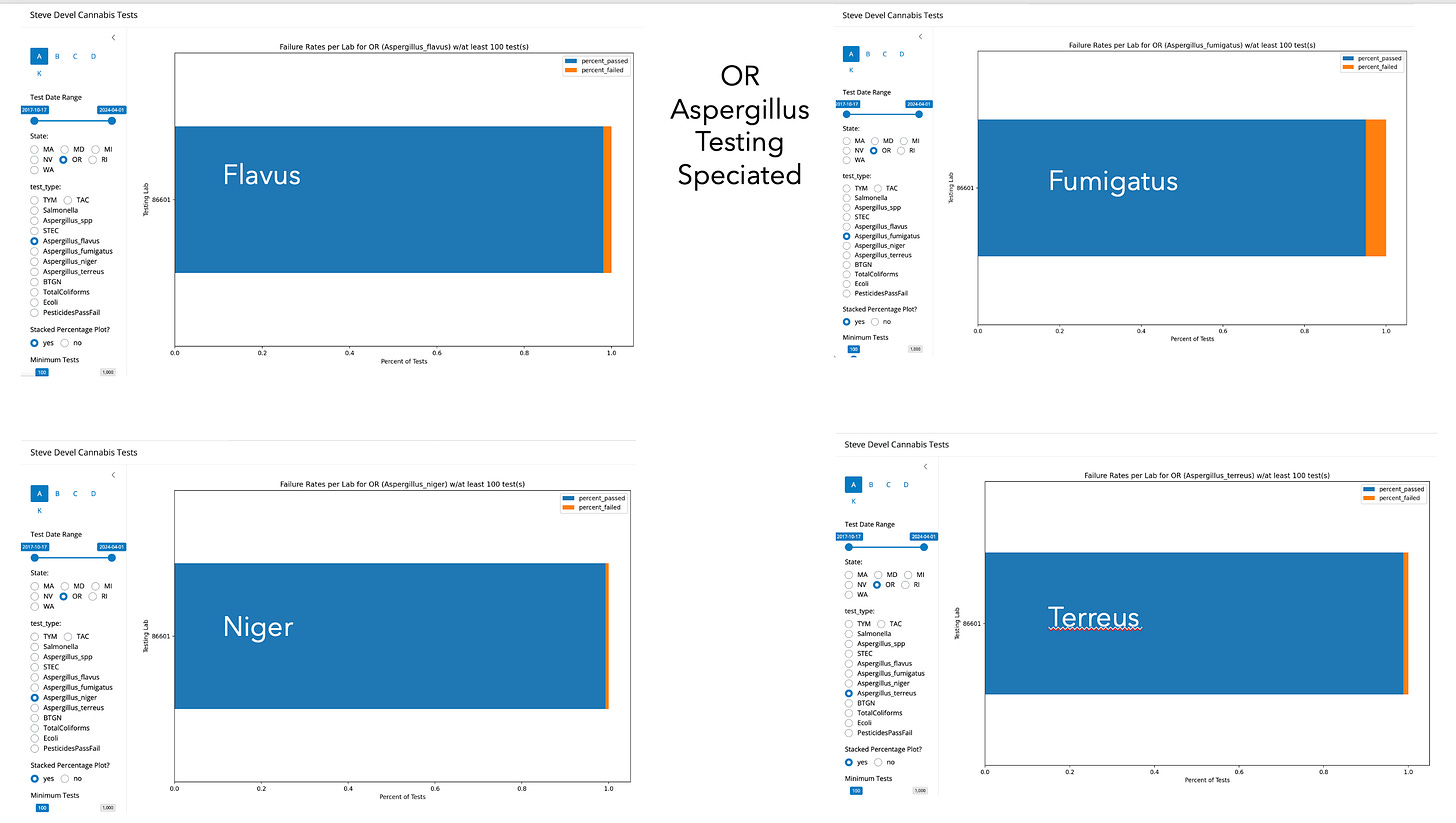
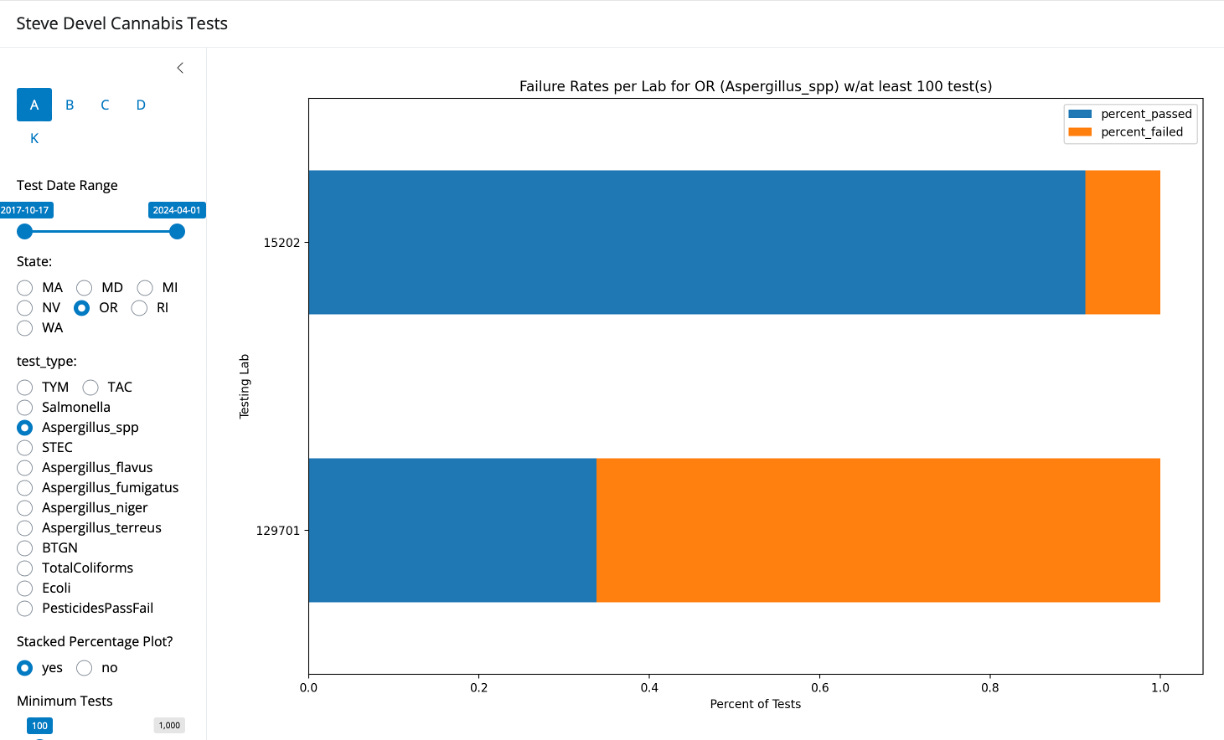
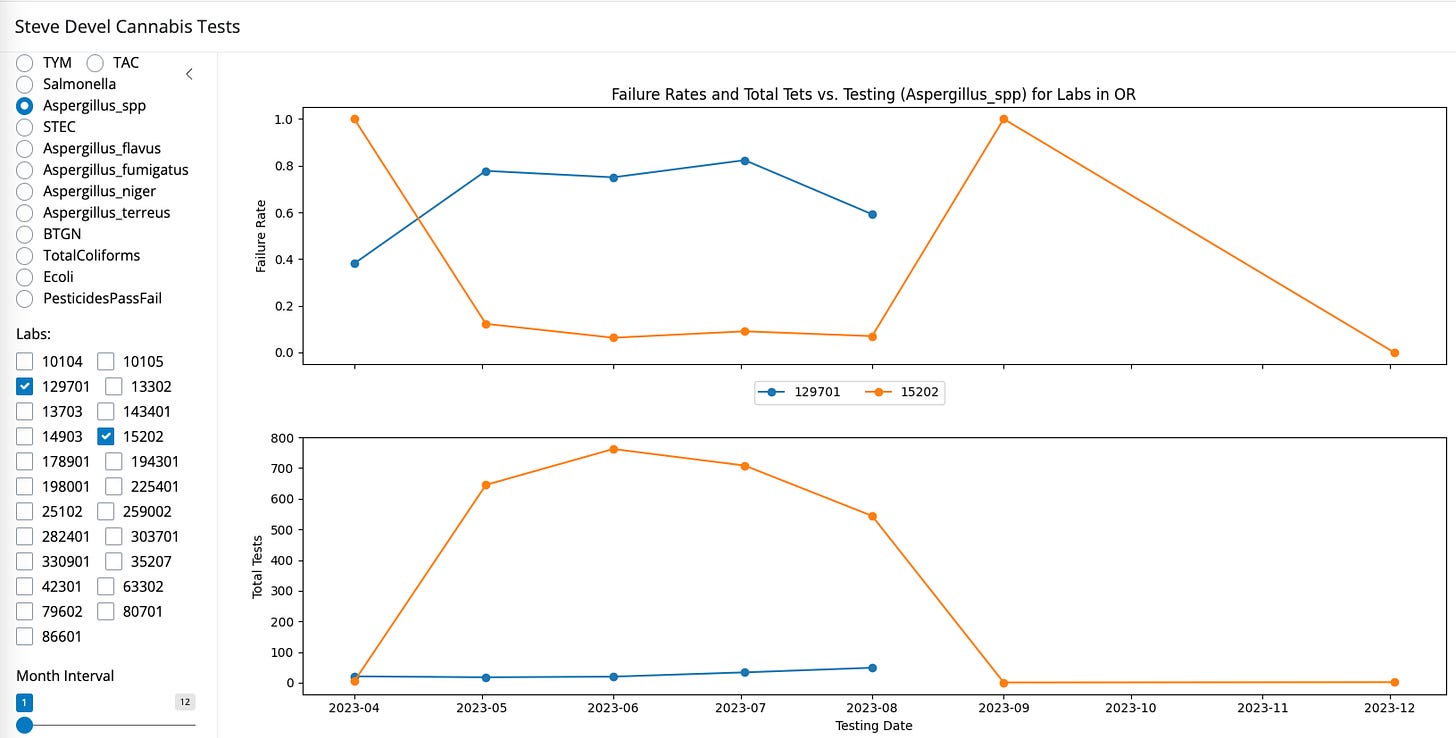
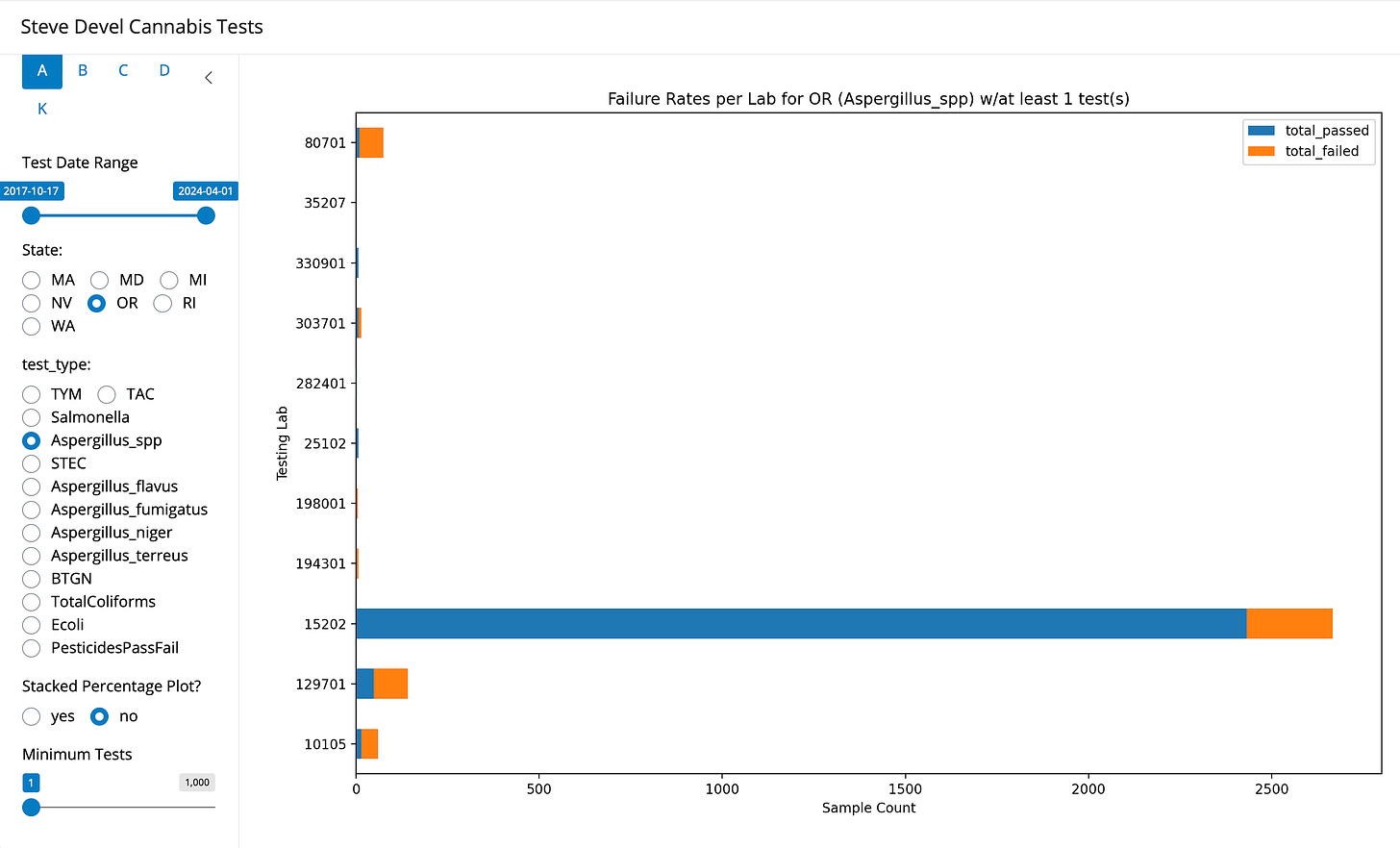
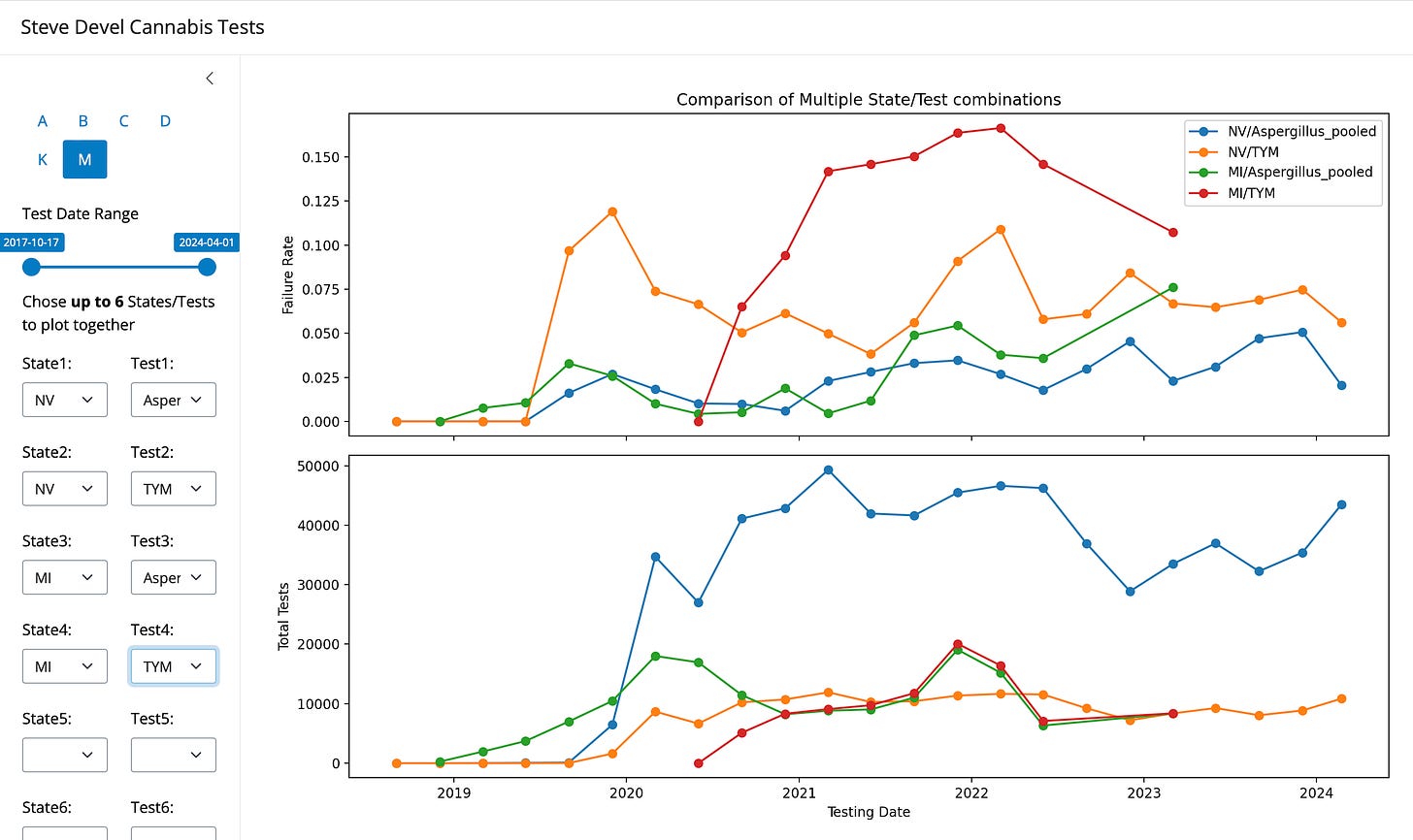

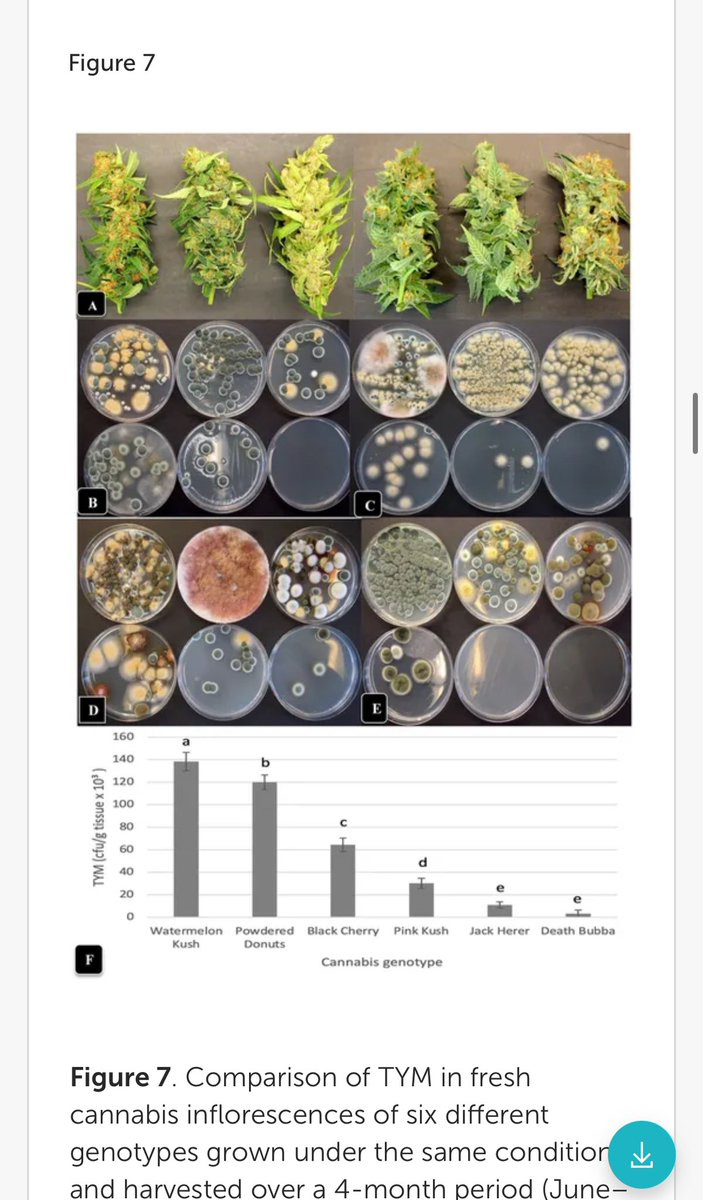
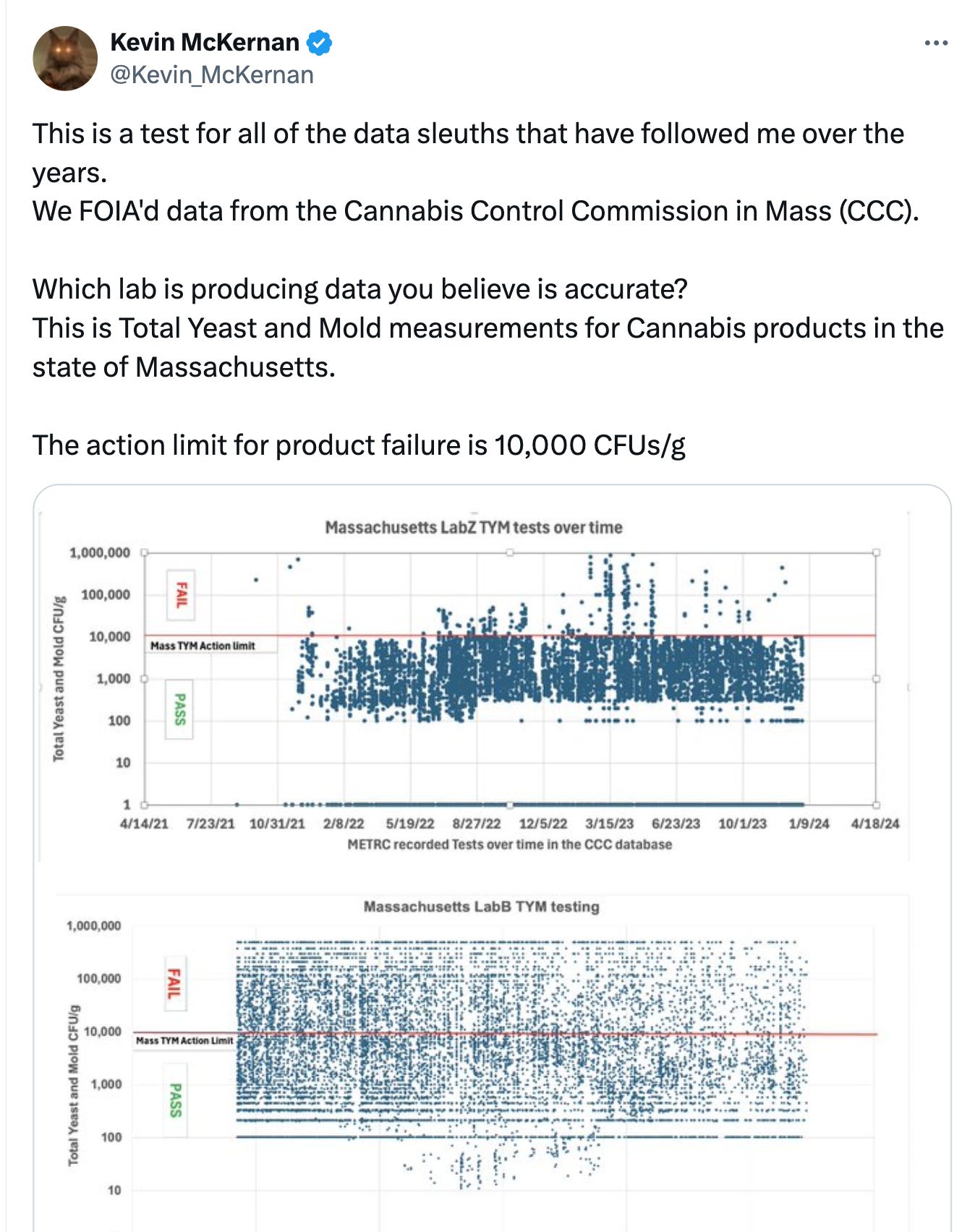
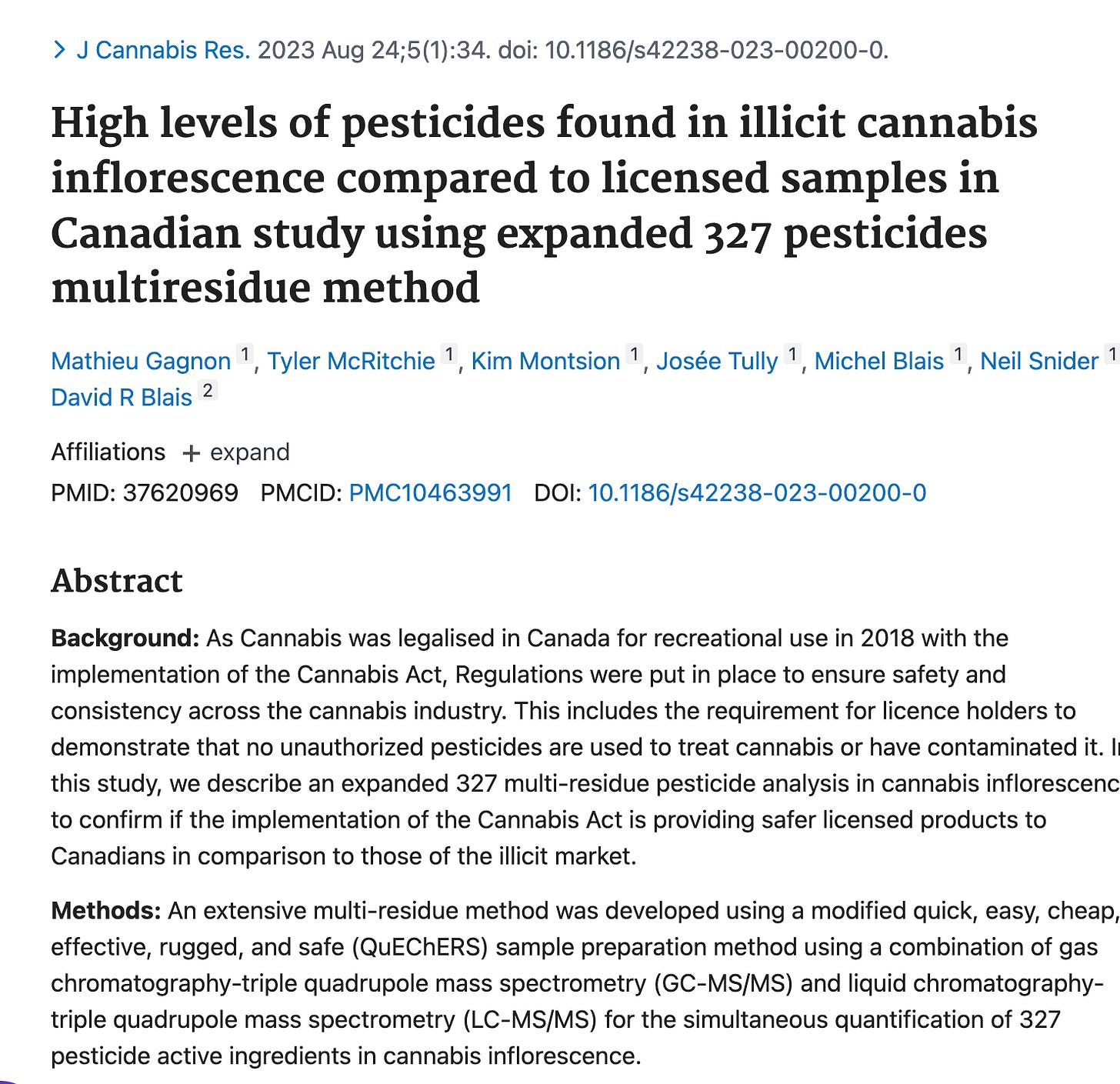
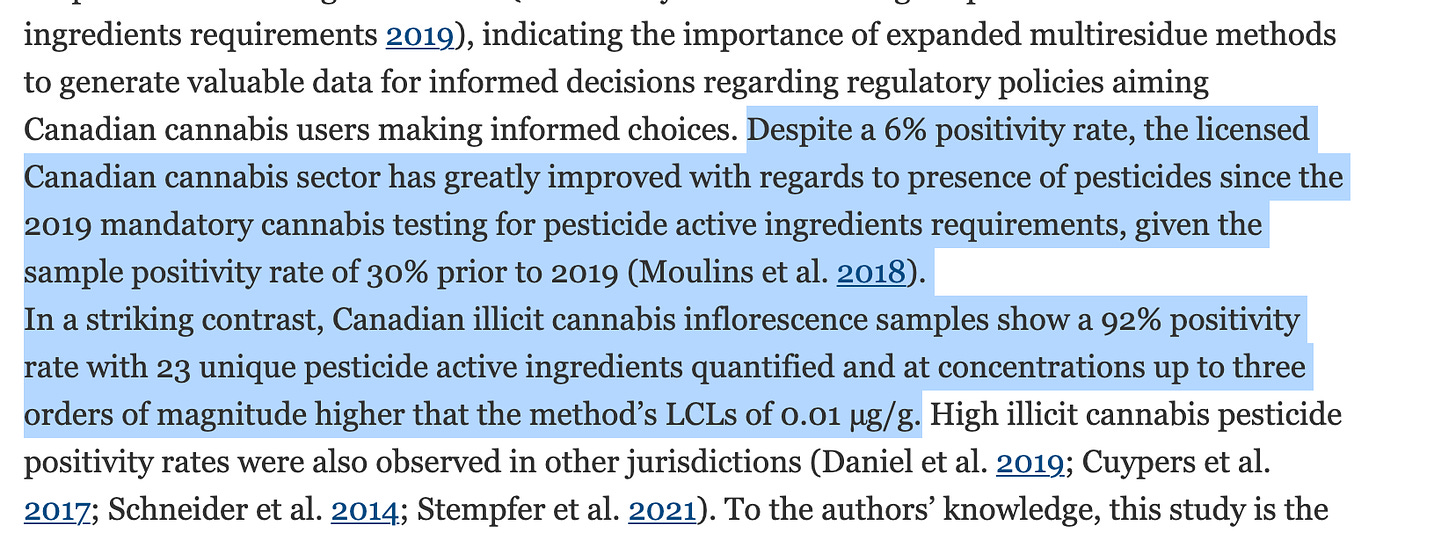
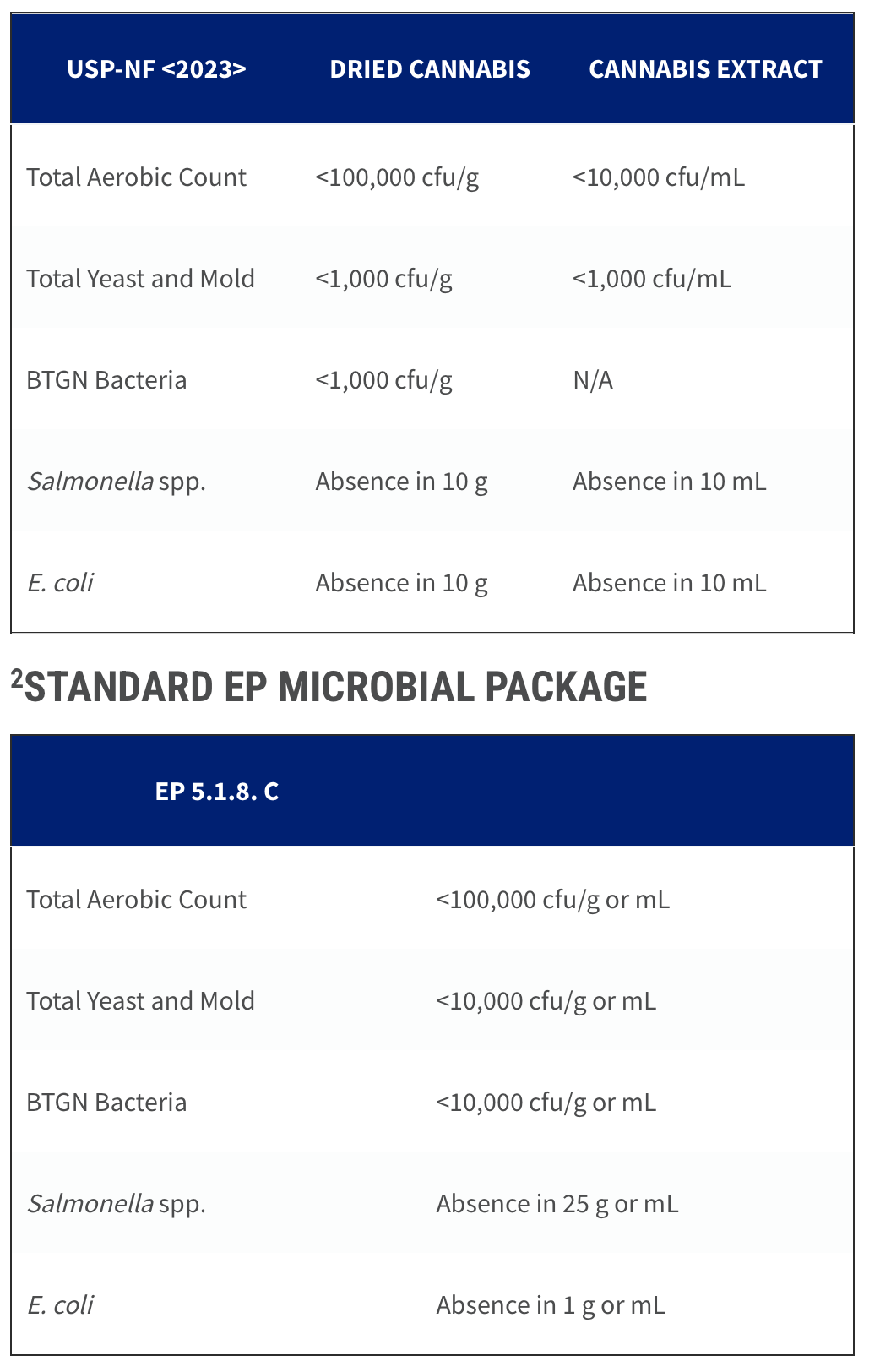
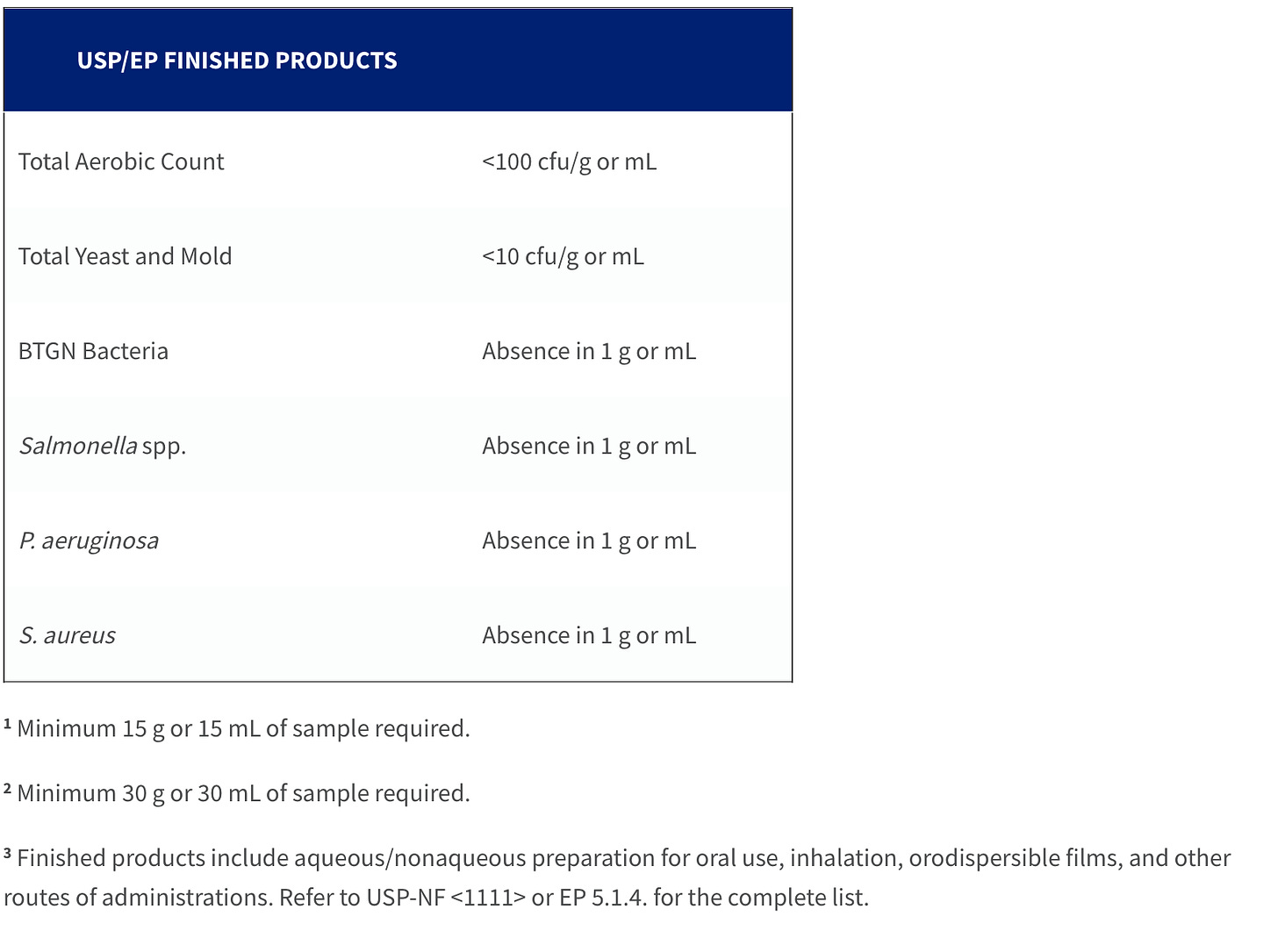
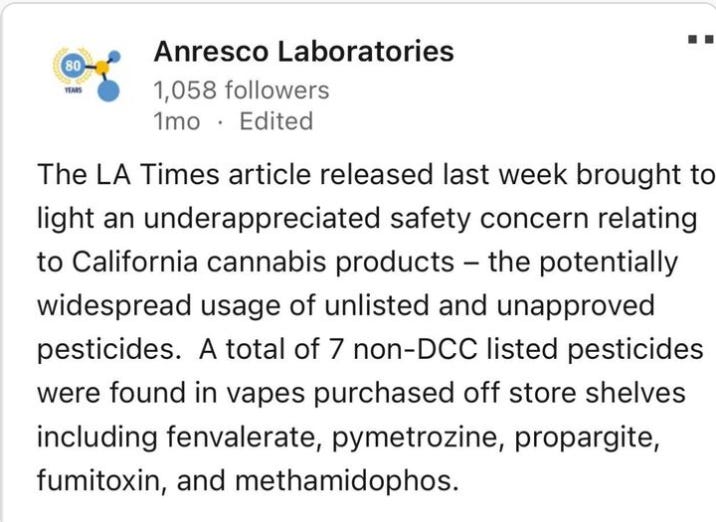

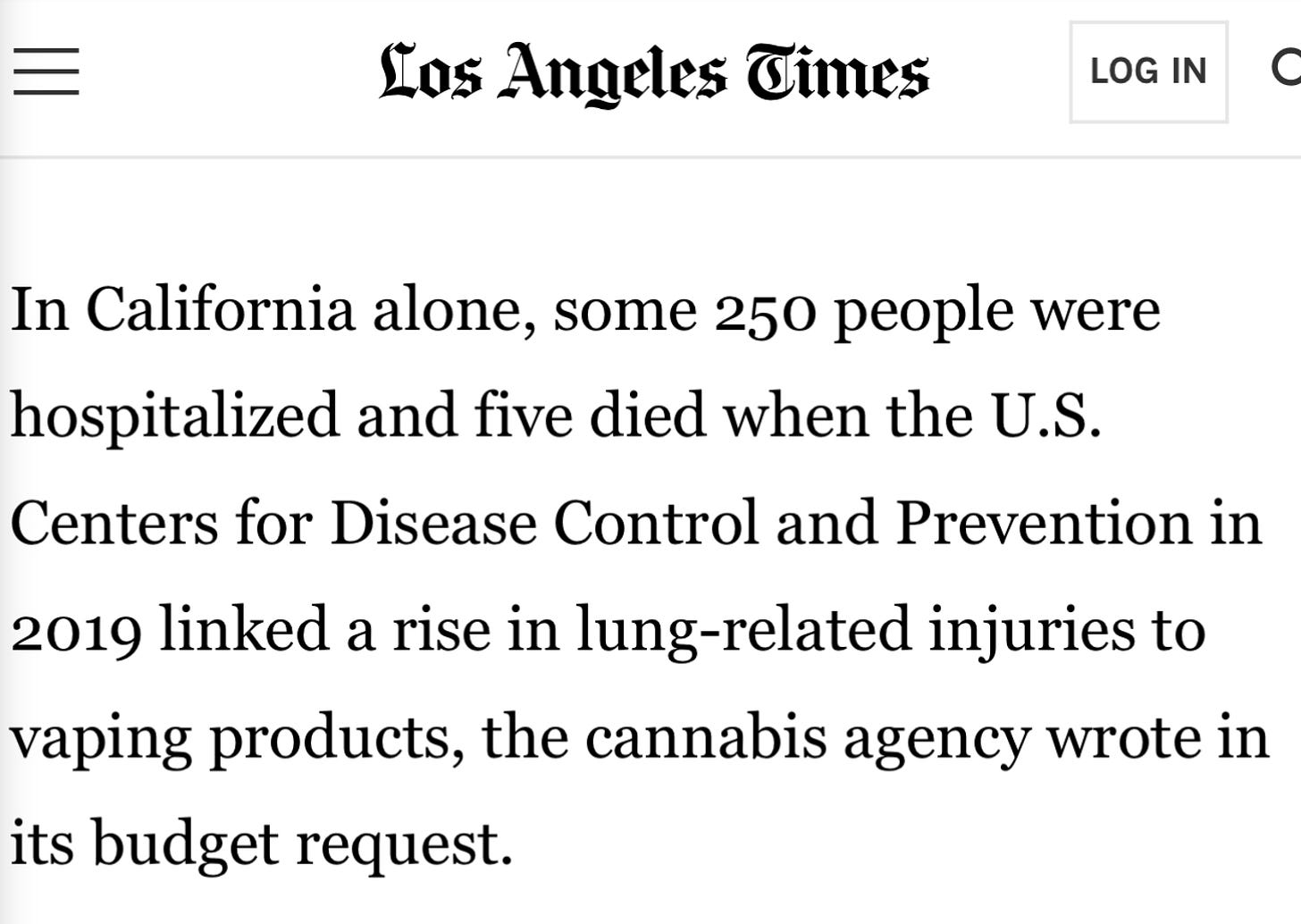

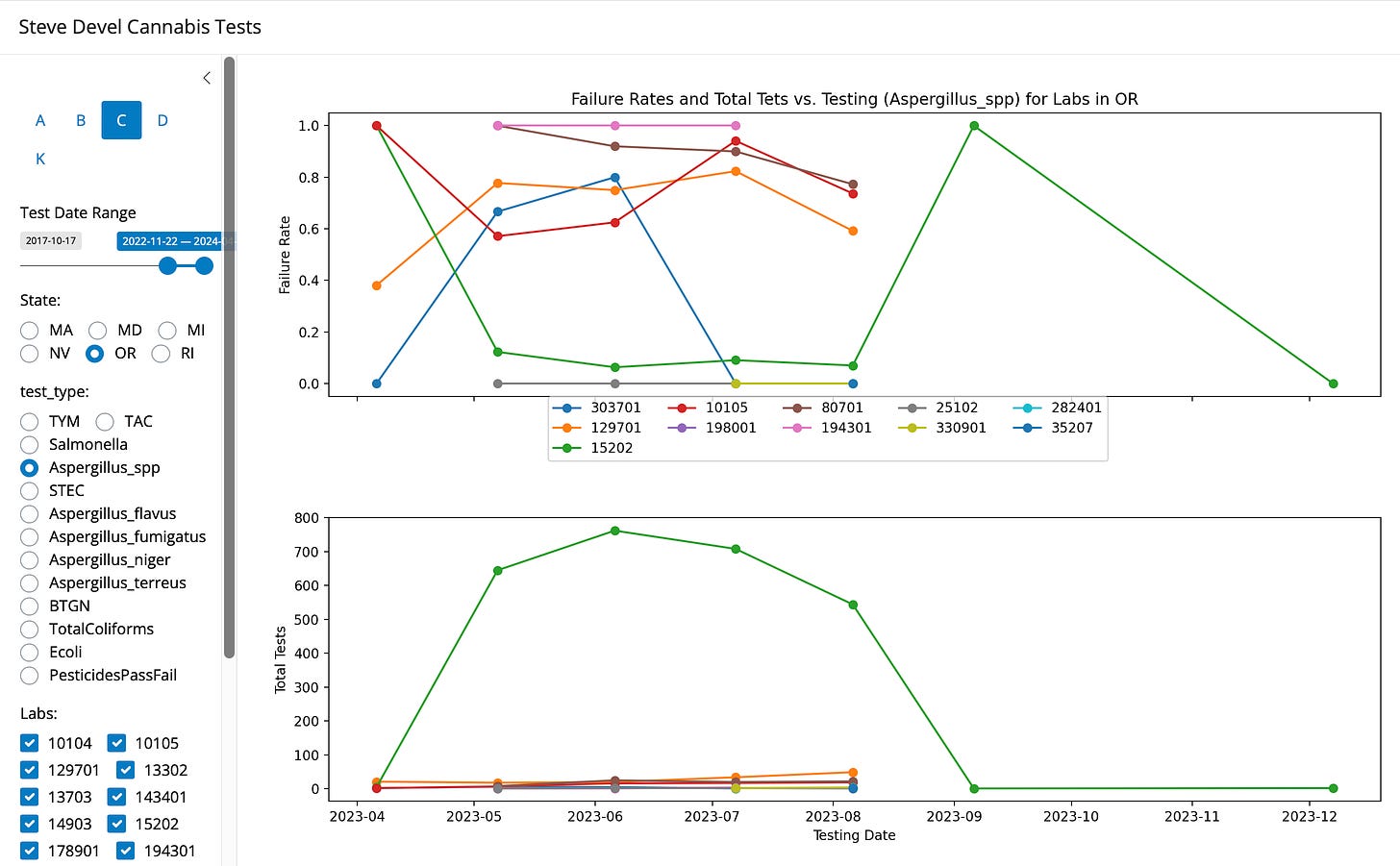
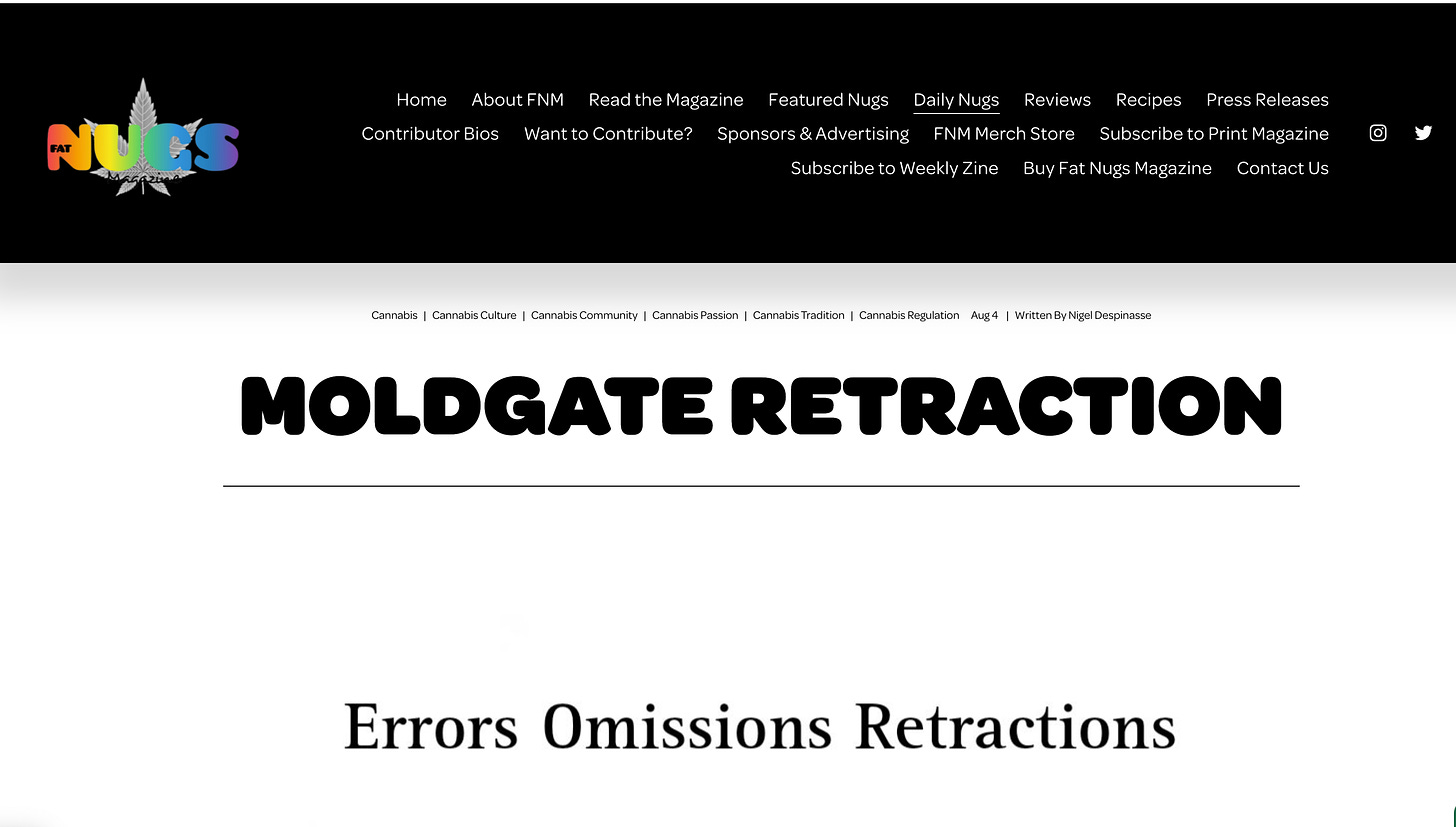



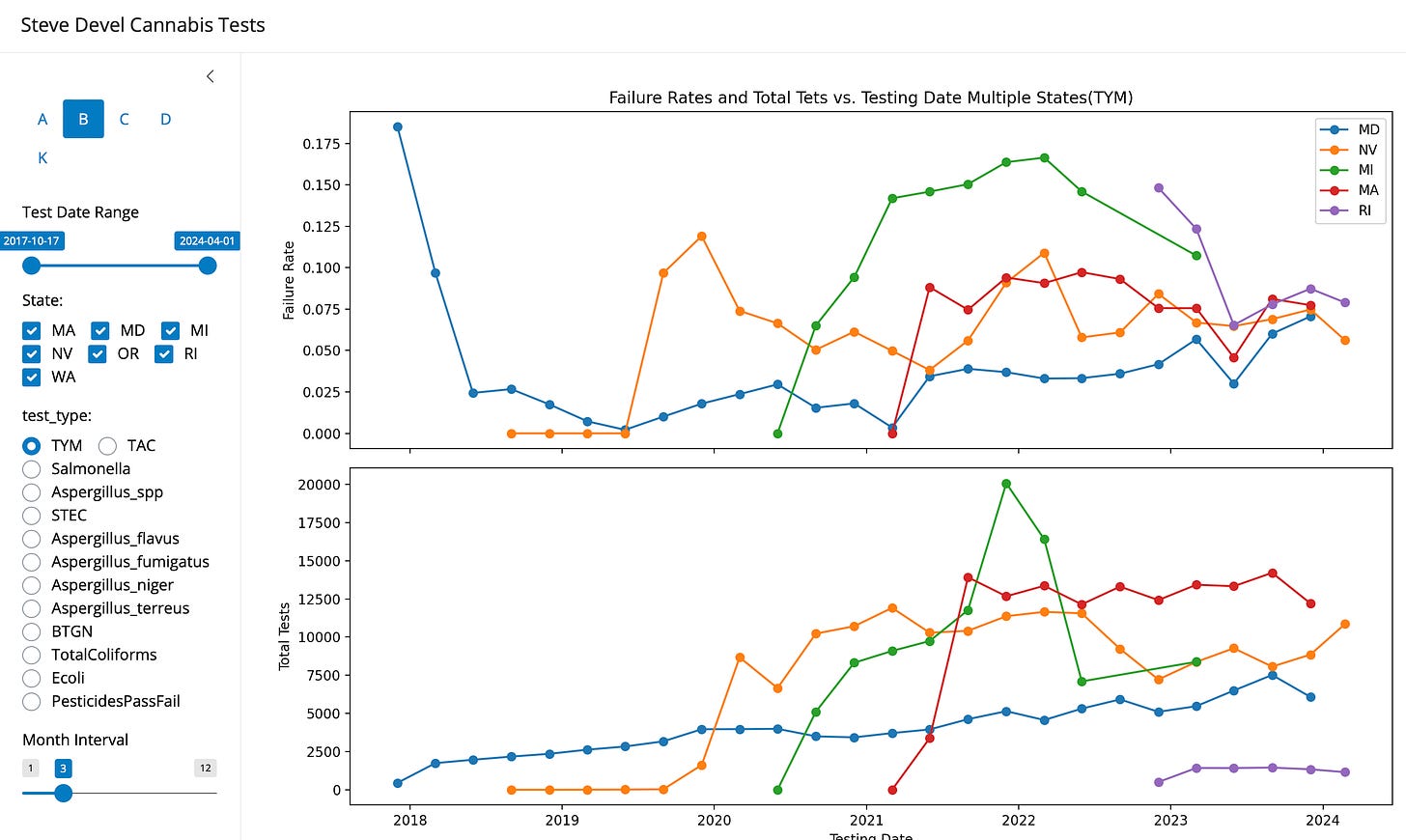
At a meta level pretty much every big industry tries to obtain regulatory capture and usually does.
Big Tobacco, Big Pharma, Big Auto, Big Military ... and the list goes on.
I finally read the article and the idea of using the black market as a control is interesting and seems novel. There were other good insights to the mechanics of regulatory capture and competing interests in the whole process.